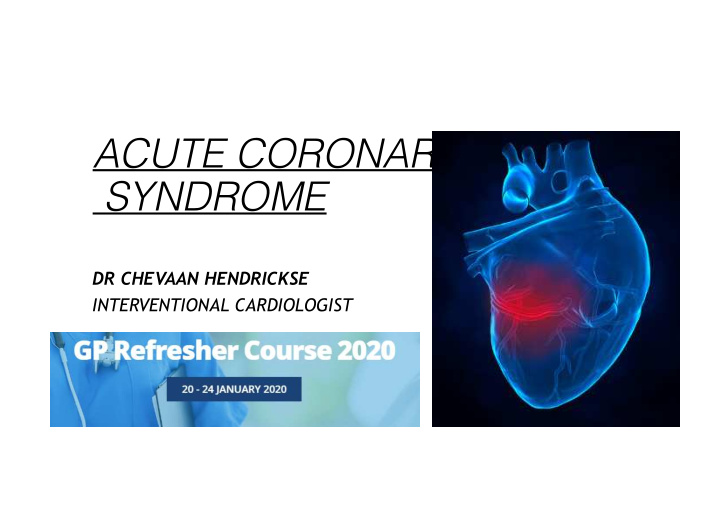



ACUTE CORONARY SYNDROME DR CHEVAAN HENDRICKSE INTERVENTIONAL CARDIOLOGIST
Conflicts of interest None
ACUTE CORONARY SYNDROMES
CHRONIC CORONARY SYNDROMES (2019)
CASE STUDY • 50 YEAR OLD • Risk factors : Hypertension, Smoker • Central, dull chest pain when playing touch rugby. @ 15 min into the game. Pain occurring more frequently. Other atypical pain syndromes. • Presentation via his GP with unstable angina • Reported to my rooms: Electrocardiogram within 10 min
ELECTROCARDIOGRAM
1. TROPONIN I < 30 ng/L � repeat at 2 hours < 30 ng/ L 2. Mild dyslipidaemia: t chol 5.8, LDL 3.4, HDL 0.9, TG 0.75 3. Normal echocardiogram 4. Normal CXR
Differential diagnosis
Unstable angina 1. New onset angina over 2 months (central, constricting, radiation) 2. Accelerating tempo (crescendo) of symptoms over 48 hrs 3. Resting angina (pain> 20 min) 4. Nocturnal angina 5. Post-infarct angina 6. Post-intervention
What should we do next? 1. INVASIVE ANGIOGRAPHY ? 2. EXERCISE STRESS TESTING ? 3. STRESS ECHOCARDIOGRAPHY ? 4. CT CORONARY ANGIOGRAPHY ? 5. MYOCARDIAL PERFUSION STUDIES ? 6. CARDIAC MRI ?
TREATMENT FOR HEART FAILURE
Electrocardiogram
Exercise stress test
Invasive coronary angiography and percutaneous coronary intervention
MYOCARDIAL INFARCTION THEORETICAL CONCEPTS
1. Myocardial infarction Type (Type 1-5) 2. Myocardial infarction vs myocardial injury 3. Troponin 4. hs troponin
Non ST elevation MI (NSTEMI) ST elevation MI (STEMI) PRICIPLES OF MANAGEMENT
The greatest challenge is the integration of clinical presentation with information derived from ECG, troponin assessment and imaging modalities into a standardised management strategy GRACE SCORE: Accurate stratification of risk both on admission and at discharge. (GRACE 2.0 risk calculator) > 120 TIMI risk score CRUSADE SCORE: BLEEDING RISK HASBLED SCORE
RISK STRATIFICATION FOR UAP/NSTEMI TIMI GRACE • AGE</> 65 • AGE • HEART RATE • RISK FACTORS • BLOOD PRESSURE • >0.5 MM ST DEVIATION • SERUM CREAT • CHEST PAIN<24 HRS AGO • KILLIP HF CLASS • POSITIVE BIOMARKER • CARDIAC ARREST • USE OF ASPRIN IN LAST 7 DAYS • INITIAL ENZYMES • ST DEVIATION
IMMEDIATE INTERVENTION
EARLY INTERVENTION WITHIN 24-28 HRS
INTERVENTION WITHIN 72 HOURS
WHAT IS THE ROLE OF THE GENERAL PRACTITIONER ? 1. DIAGNOSIS 2. INITIAL RISK STRATIFICATION 3. STABALIZATION 4. INITIATION OF MEDICAL THERAPY
ANTI-THROMBOTIC THERAPY 1) ANTIPLATELET AGENTS (DUAL ANTIPLATELET THERAPY) ASPRIN + P2Y12 INHBITOR 2) ANTICOAGULATION 3) INTRAVENOUS ANTIPLATELET THERAPY (ANTI-IIb/IIIa)
ANTIPLATELET TRIALS
ANTICOAGULATIO N DO NOT SWITCH ANTICOAGULATION BEFORE PCI Arixtra 2.5 mg SC daily FONDAPARINUX VS CLEXANE OASIS-5 TRIAL
CORONARY ANGIOGRAPHY
PERCUTANEOUS CORONARY INTERVENTION
WHAT ABOUT PATIENTS ON ORAL ANTICOAGULANTS ?
Suggested strategies to reduce bleeding risk related to PCI 1) RADIAL APPROACH 2) ADD A PROTON PUMP INHIBITOR
EVIDENCE-BASEDPERFORMANCE MEASURES
ST ELEVATION MYOCARDIAL INFARCTION 1. ST-segment elevation 2.5mm in men < 40 years, in leads V2– V3 2. 2mm in men > 40 years in leads V2–V3 3. 1.5mm in women in leads V2–V3 4. 1mm in the other leads [in the absence of left ventricular (LV) hypertrophy or left bundle branch block LBBB)].
ER MANAGEMENT (ACLS/ABC)
WHEN ANTICIPATING PRIMARY PCI
IF NO PRIMARY PCI
• Discovered in 1930 • 1945: VTE Rx • 1980’s: AMI • ISIS TRIALS • ASA RR 25% • STREP RR 25%
FIBRINOLYTICS tenecteplase tissue plasminogen activator (TNK-tPA) is equivalent to accelerated tPA in reducing 30 day mortality, but is safer in preventing non-cerebral bleeds and blood transfusion, and is easier to use in the pre-hospital setting
1. Tenecteplase tissue plasminogen activator (TNK- tPA) is equivalent to accelerated tPA in reducing 30 day mortality, 2. TNK is safer compared to TPA in preventing non- cerebral bleeds and blood transfusion, and is easier to use in the pre-hospital setting
ANTICOAGULANT CO-THERAPIES
CONTRAINDICATIONS
EARLY ANGIOGRAPHY AND PCI AFTER FIBRINOLYSIS 1. PCI RECOMMENDED BETWEEN 2-24 HRS
PERCUTANEOUS INTERVENTION
ANTICIPATE AN ADMISSION FOR 48-72 HRS TO SCREEN FOR COMPLICATIONS 1. MYOCARDIAL DYSFUNCTION AND CARDIAC FAILURE 2. MECHANICAL COMPLICATIONS (FREE WALL RUPTURE, PAPILLARY MUSCLE RUPTURE, VSD) 3. ARRHYTHMIAS (VT, AF, VF) 4. PERICARDITIS
MYOCARDIAL INFARCTION WITH NON- OBSTRUCTED CORONARY ARTERIES
MEDICAL THERAPY Dual Antiplatelet Therapy FOR 12 MONTHS
STRATEGIES OF MEDICAL MANAGEMENT
IN SUMMARY 1. Have an institutional approach to chest pain 2. Exclude other possible fatal causes • ACS and the differential diagnosis as discussed 3. Electrocardiogram within 10m minutes of arrival 4. Biomarkers and repeat at 3 hours to confirm or exclude a rise/fall. 5. If unsure, then pick up the phone and call 6. If suspecting an ACS, commence AspIrin loading and activate the ACS network 7. STEMI: time is muscle. If no PCI � Lysis
References • Uptodate • ESC guidelines • ESC textbook of cardiovascular medicine 2019 • NEJM • JACC • Brawnwald’s Cardiovascular disease: ninth edition • Personal experience (Life) • Google images
Recommend
More recommend